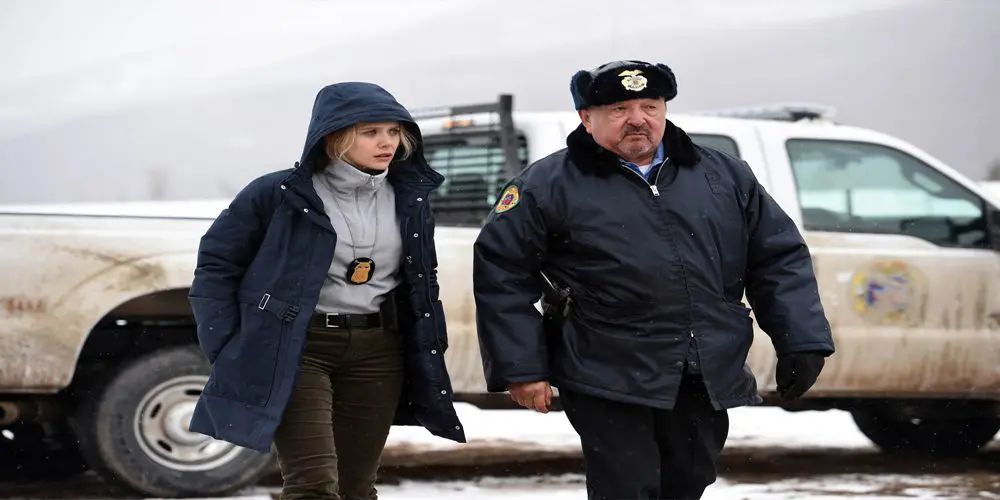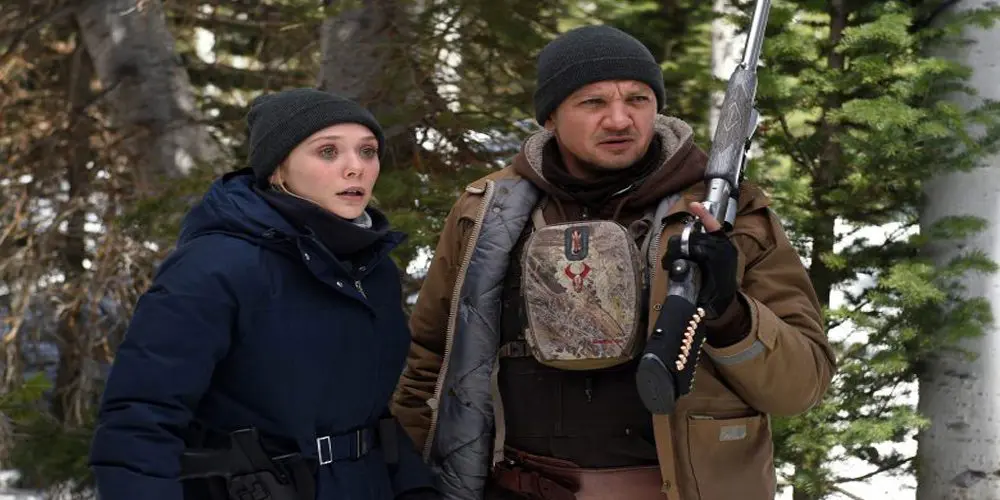According to the shaggy, matter-of-fact medical examiner on the Wind River Indian reservation, what happens when you gulp big mouthfuls of sub-zero air is that your lungs start to fill up with blood. The alveoli, the clusters of balloon-shaped air sacs, they burst. If the air is cold enough – on the reservation, a slab of wintry land frozen into the middle of Wyoming, temperatures often reach twenty below – then the liquid in the lungs starts to crystalize. The medical diagnosis for this is pulmonary haemorrhage. It’s common in racing animals – horses, greyhounds – and human athletes. In Wind River, this is explained during the autopsy of a young Native American woman, Natalie (Kelsey Asbille), who had been beaten, sexually assaulted, and had run flat-out for six miles until she collapsed in the snow and drowned in her own blood.
Murder on Indian reservations is a federal crime, so the FBI despatches an untested but well-intentioned rookie agent from Las Vegas, Jane Banner (Elizabeth Olsen), to ascertain the circumstances surrounding Natalie’s death. But, again, according to the medical examiner, a pulmonary haemorrhage was the cause of death – and a pulmonary haemorrhage isn’t murder. Banner can’t mobilize the full investigative might of the Bureau without official confirmation that a crime has been committed, so she’s forced to conduct her own, unofficial investigation – one she’s woefully unprepared for. Ten minutes after arriving on the reservation in her standard-issue windbreaker, it’s coolly explained to her that if she doesn’t borrow some cold-weather gear from a local, she’ll be dead in ten minutes.
Banner is inexperienced and ill-equipped for the climate, but she’s smart, idealistic and determined. She recognises that if she’s honest about the official cause of death, her superiors will likely recall her to Vegas; she keeps that to herself. She recognises that her unfamiliarity with the environment and the apathy of the locals towards outsiders are going to stymy her inquiries, so she enlists the help of a local U.S. Fish and Wildlife agent, Cory Lambert (Jeremy Renner), who found the body in the first place, and who has an uneasy but respectful relationship with the indigenous Arapaho residents – who include his ex-wife and former in-laws. Cory’s job is to prevent the encroachment of wolves and lions and suchlike onto the reservation. “I hunt predators,” he explains. “Well,” replies Banner, “come and hunt one for me.”
This lurid setup is thanks to Taylor Sheridan, the screenwriter who scripted Denis Villeneuve’s Sicario and David Mackenzie’s Hell or High Water, and who also directs here. Sheridan might not ever write a movie that’s a barrel of laughs, but he’s rapidly becoming a master of certain hard-bitten genre essentials; the Mexican standoff, the shootout, the fistfight, the crime-scene, the procedural politics of investigation. He’s good at rummaging through a place; in Sicario, it was Juarez, Mexico, during the height of the U.S. War on Drugs; in Hell or High Water, it was West Texas, where frontier justice ruled; and here, in Wind River, it’s the poverty-stricken reservation, a place of never-ending winter, and a home to predators of every kind. The locations and the people and the politics are so blighted that it’s a surprise they’re this filmable. But Wind River is a shockingly gorgeous film, and a gripping, satisfying one. There’s poetry in its stillness. As it’s explained to us in the film’s dying moments, the snow and the silence are beloved by the Natives because everything else has been taken from them.

In a lesser film, this would be subtext; flavour for a familiar dish. But Wind River fashions the logistics of Wyoming’s unending winter wilderness into sharp narrative components. This is the rare crime thriller that has no use for a traditional mystery. Life on the reservation is stretched so thin – a police force of six, to cover an area the size of Rhode Island – across such a vast and unforgiving landscape that the simple act of pursuing leads is a mammoth undertaking. There aren’t enough people nearby for a killer to remain hidden for long, but with so little manpower, and so much distance between the heroes and the short list of suspects, witness and locations they’ll need to visit, the investigation is constantly beset by complications and frustrations.
This leaves lots of time for introspection and quiet character development, which is aided by an excellent cast. It is, perhaps, worth the raising of an eyebrow that a murder-mystery on an Indian reservation is fronted by two lily-white characters, but as valid a criticism as that might be, there’s an intentional sense of Olsen’s earnest cluelessness playing off of Renner’s career-best turn as a go-between who has nothing in common with her, but still finds himself held at arm’s-length by the Natives whom he considers family. This dynamic serves the scenario well, and the handful of indigenous actors who are present – including Comanche actor Gil Birmingham, who is superb as Natalie’s grieving father, and the legendary Graham Greene as an overworked police chief – lend so much authenticity and pathos to the story that you scarcely notice (or care) that the leads fit such a standard Hollywood mould.
This is to say nothing of how atypical it feels for the nominal heroes in a story like this (one of them bitterly-divorced, no less) to have their relationship taken adroitly to the brink of romance, and then never taken further. The scene is there, the dreaded one in which a character offers the other character coffee, and there’s a moment where you wonder if that might be a euphemism. Not here, though. Cory offers Agent Banner coffee, but also well water. And she takes the well water. It’s just that kind of film.

Of course, over that well water, the two characters discuss the case, and each other, at a length which allows some of the clunky dialogue to become noticeable – particularly when Cory starts to wax poetically about the extraordinary strength and resilience of his Native friends and family. This is, for the most part, a smartly-written film, but the talkier it gets the less authentic it feels. It would sometimes be better off letting Sheridan’s stylishly simple filmmaking do the work on its own; his delicate navigation of Banner’s learning curve, her relationship with Cory, and their putting-together of the various chilly clues, is what makes Wind River so consistently engaging, despite its glacial pace.
When it comes time to produce an explanation, rather than accumulating indirect revelations in the manner that most films like this consider essential, Sheridan instead does it by means of a single flashback – a welcome, unselfconscious choice, but a critical moment in the story that nonetheless feels hazier than it ought to by switching the tense and the perspective for the first and only time in an otherwise straightforward film. This is Wind River’s only structural flourish, and it’s not a particularly showy one, but it arrives when clarity is most paramount, and so feels a little jarring.
These are minor criticisms, though, and mostly irrelevant in the grand scheme of what Wind River accomplishes; on the one hand a confident and satisfying thriller, with sickening revelations and a climax that sees blood deservedly spilled onto the thirsty snow, and on the other hand an acknowledgement that the justice done by the film’s heroes is not nearly enough with respect to the larger injustice done to Native Americans. But Wind River, in rooting its story among a maligned and underrepresented community, takes an important step towards expanding awareness of that community’s struggles.




